Explore Spain and Portugal by train in just one week on this rail itinerary which takes you from Barcelona to Valencia, Madrid, Porto and Lisbon, with delicious food and drink along the way.
* This site contains affiliate links, where I get a small commission from purchases at no extra cost to you.
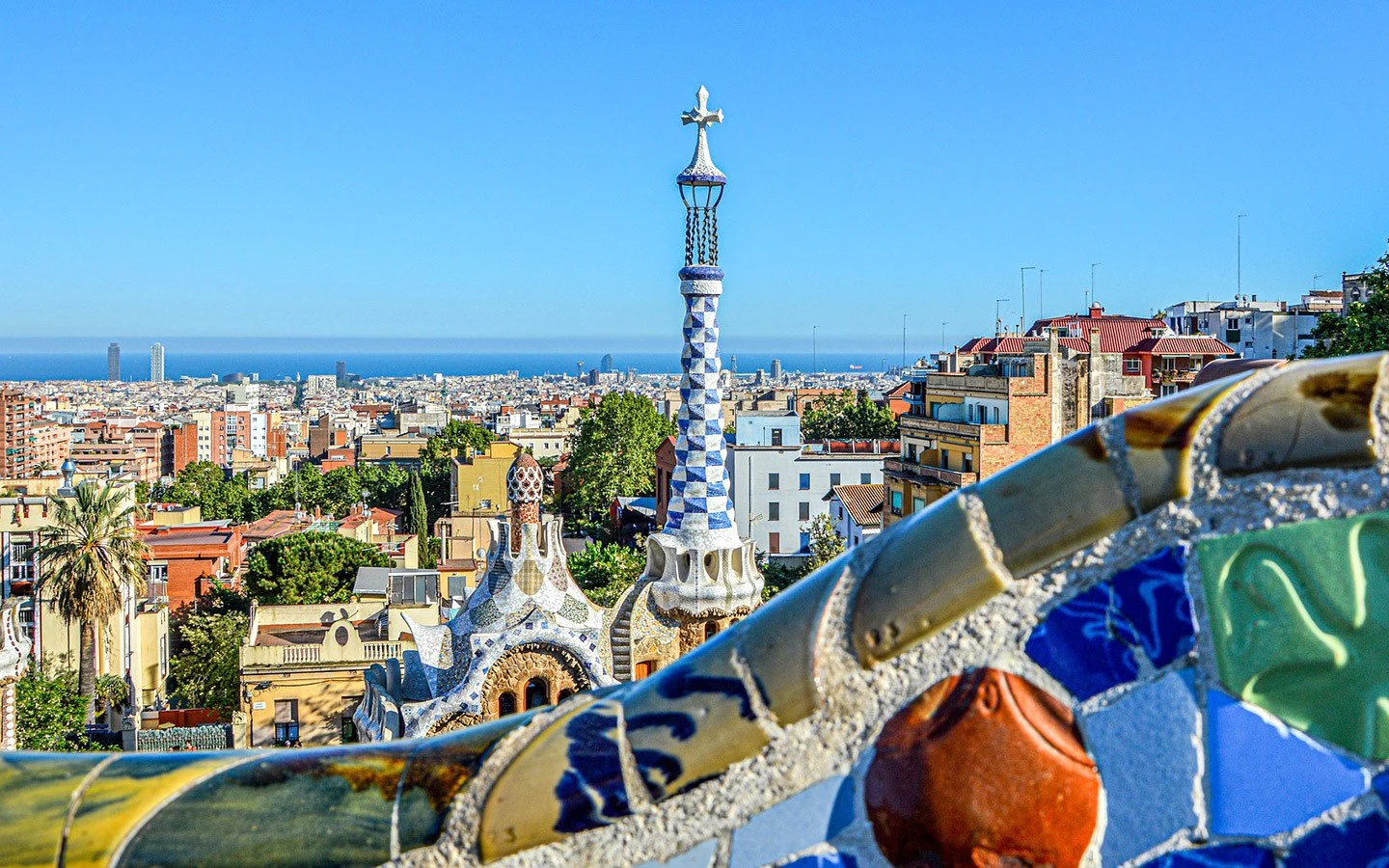
From paella to port, churros to custard tarts – eat and drink your way through two countries as you travel across Spain and Portugal by train. This one-week rail trip takes you from the Mediterranean to the Atlantic, starting in Barcelona and Valencia before heading inland to the Spanish capital Madrid and across to Porto and Lisbon.
This Spain and Portugal rail itinerary will show you which trains to take, how much they cost, how to book and what to see and do along the way – with quirky architecture, world-class artworks, golden sand beaches, river boat trips and plenty of tapas.
One-week Spain and Portugal by train itinerary
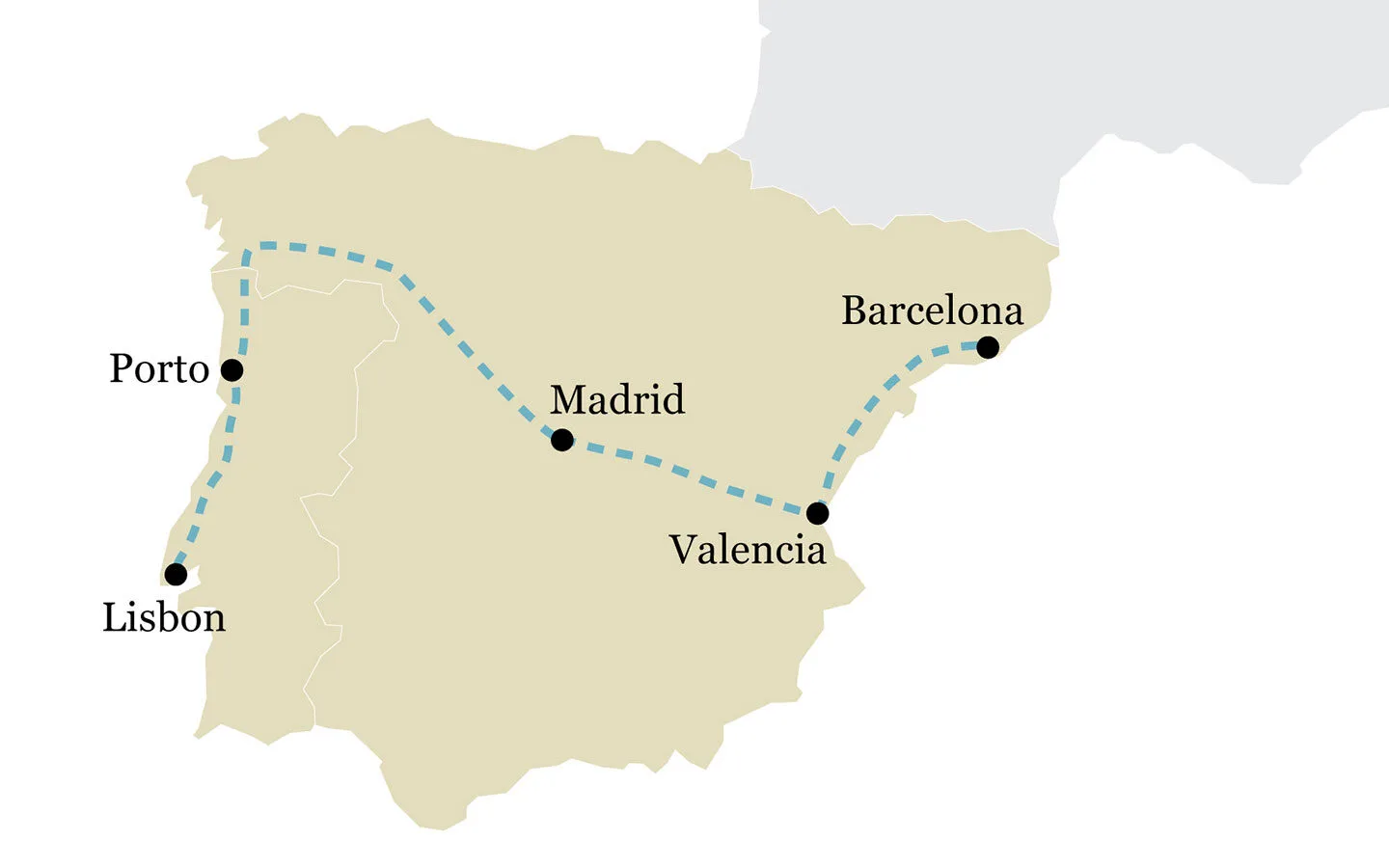
Day 1: Barcelona
Start your journey across Spain and Portugal by train with a full day in the seaside city of Barcelona. The Catalan capital’s 2000 years of history, impressive art and architecture, and inventive culinary scene have helped make it one of Europe’s most popular city break destinations – and it can feel like it when you’re walking down the bustling Las Ramblas.
Explore the bustling Gothic quarter with an audioguide walking tour* and discover the Barcelona’s cathedral, Roman ruins, palaces and royal squares as you get an insight into the history and legends that form the foundations of this city.
Architect Antoni Gaudí left his mark across the city with his unique take on Art Nouveau. You can see his handiwork at Parc Güell, Casa Batlló, Casa Milà and the unfinished Sagrada Família. This giant basilica has been under construction since 1882 and won’t be finished until at least 2026. But you can still take a tour* to see work in progress.
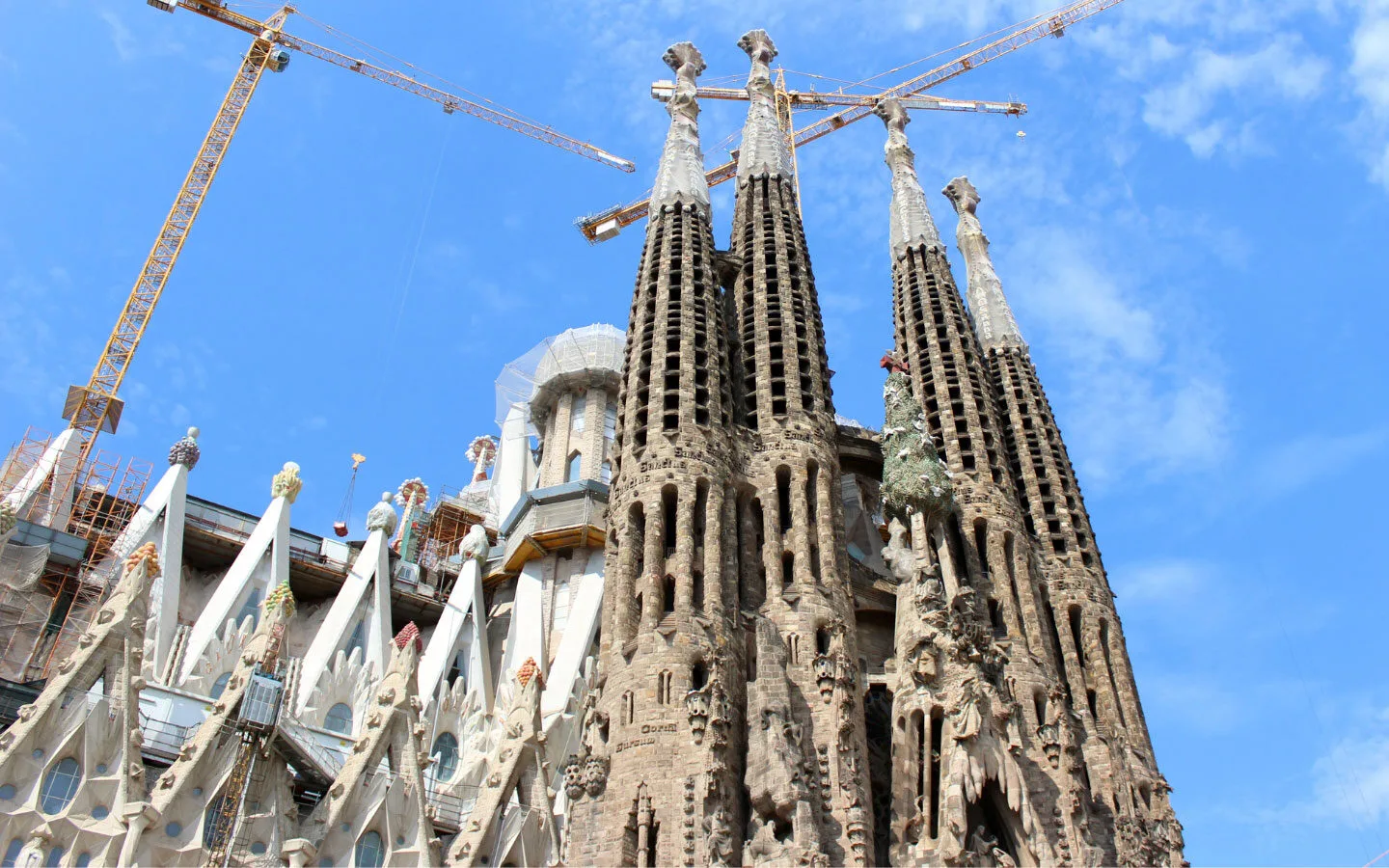
When you get hungry, stock up on local cheese and jamón at La Boqueria food market. Then take the cable car to Montjuïc to watch the sun set over the city and toast the evening with a glass of cava at a beachside bar in the seafront neighbourhood of Barceloneta.
Where to stay in Barcelona: The Motel One Barcelona-Ciutadella* is a stylish, good-value hotel near the main city sites, with a 24-hour lounge bar and a rooftop terrace overlooking Ciutadella Park. Rooms are small but bright, with splashes of colour coming from the chain’s signature turquoise details and murals by a local artist.

Day 2: Barcelona > Valencia
Next morning, take the 3.5-hour Torre Oro train journey south along the coast to Valencia, which departs from Barcelona Sants station at 08.30 and arrives into Valencia’s Estacion del Norte (north station) at 11.55. Spain’s third-largest city, Valencia hosts the famous Las Fallas festival each March to welcome spring in riotous style.
Take a walk around the Ciutat Vella (old town) for some of Valencia’s most impressive historic buildings, including the Lonja de la Seda medieval silk market, Torres de Serrano city gates and Valencia Cathedral – where you’ll allegedly find the Holy Grail, and will definitely find impressive views over the city from the top of the Micalet belltower.

Visit the futuristic City of Arts and Sciences – a complex of buildings, bridges and turquoise pools which looks like something from a sci-fi show. It’s actually a park built in the late 1990s to redevelop an old dry riverbed. Its unique buildings are home to the Oceanogràfic aquarium, a 3D cinema, science museum, opera house and sculpture garden.
If you fancy an afternoon on the beach, Valencia has a string of wide, sandy beaches stretching north and south of the city. Admire tiled buildings in the traditional fisherman’s district of Cabanyal-Canyamelar. Then take an evening stroll along the seafront promenade before trying traditional local dishes like Fideuà (seafood noodles) and the original Paella Valenciana, made with chicken, rabbit, snails, garrafó beans and rice.
Where to stay in Valencia: The Hotel Balandret* is right on the beach, 30 minutes from the old town by public transport, with views of the ocean or marina and a sunny terrace restaurant. The owners are proud of their local heritage, with sculptures and a giant mural made of 1000 botijos (traditional water jars) decorating the reception area.

Day 3: Valencia > Madrid
The following morning, take the short 1 hour 45 minute AVE high-speed train to Spain’s capital Madrid. The 10.10 service from Valencia’s Joaquín Sorolla station arrives into Madrid Atocha at 12.32. Along the way it climbs upwards from sea level to 700 metres, with views of the Contreras Reservoir and Hoces del Cabriel Nature Reserve.
Then you have the afternoon and the next morning to explore Madrid. Admire the city’s architecture in the Plaza Mayor, take a walk down the Gran Vía and people-watch in one of the cafés in Puerta del Sol square. Don’t miss a stop off for churros con chocolate – sticks of deep-fried dough rolled in sugar and dipped into thick hot chocolate.
Take a breather and stop for a picnic in one of Madrid’s parks – there’s Retiro Park with its lawns, lakes and glass Palacio de Cristal, the Parque del Oeste with its Egyptian temples, or the giant Casa del Campo park – which you can reach by cable car on the Teleférico de Madrid. Or football fans can take a tour* of Real Madrid’s Bernabéu Stadium.

Start your evening in Madrid at the Círculo de Bellas Artes, an arts and cultural centre with a rooftop terrace bar that’s the perfect spot to watch the sun go down with a cocktail. Then head out on a food and drink-filled tour* of the city’s tapas bars. Or visit the beautiful glass Mercado de San Miguel, with stalls selling treats from across Spain.
Where to stay in Madrid: Palacio Plaza Conde Miranda* apartments are in an 18th-century building in a quiet square close to San Miguel market. They’re smart and modern, with one or two bedrooms and a kitchen/lounge. Each is themed around a couple from films, TV series or books – from Elizabeth and Mr Darcy to Homer and Marge Simpson.
Read more: Visiting Madrid on a budget

Day 4: Madrid > Porto
The next morning, enjoy Madrid’s art and culture before catching the train across the border to Portugal. Art-lovers are spoilt for choice in Madrid’s ‘Golden Triangle’, with modern art at the Reina Sofia museum, European art at the Thyssen-Bornemisza and Spanish art at the famous El Prado (though you may need to book in advance*).
Or you can overdose on gold, marble and frescoes at the elaborate Palacio Real. It’s the largest palace in Europe and the official residence of the Spanish Royal Family – though they actually live outside the city and it’s only used for ceremonies. There are over 3400 rooms, 50 of which you can visit on a tour to admire the lavish interiors.

Previously we suggested taking the Lusitania overnight train from Madrid to Lisbon next, but the service has been discontinued so it’s now easier to head to Porto first, which takes just under 7 hours, changing in Vigo close to the border. Catch the 14.30 train from Madrid Chamartin to Vigo Guixar, arriving at 19.20. Then change onto the 19.56 from Vigo which arrives in Porto Campanha at 21.18, just in time for a late dinner.
Where to stay in Porto: If you fancy splashing out, the luxurious Yeatman* in Vila Nova de Gaia has one of the best views in town and five-star service. From the decanter-shaped infinity pool to the grape-based spa treatments, they’ve gone all out with the wine theme. There’s also a two-Michelin-starred restaurant and an extensive wine cellar.
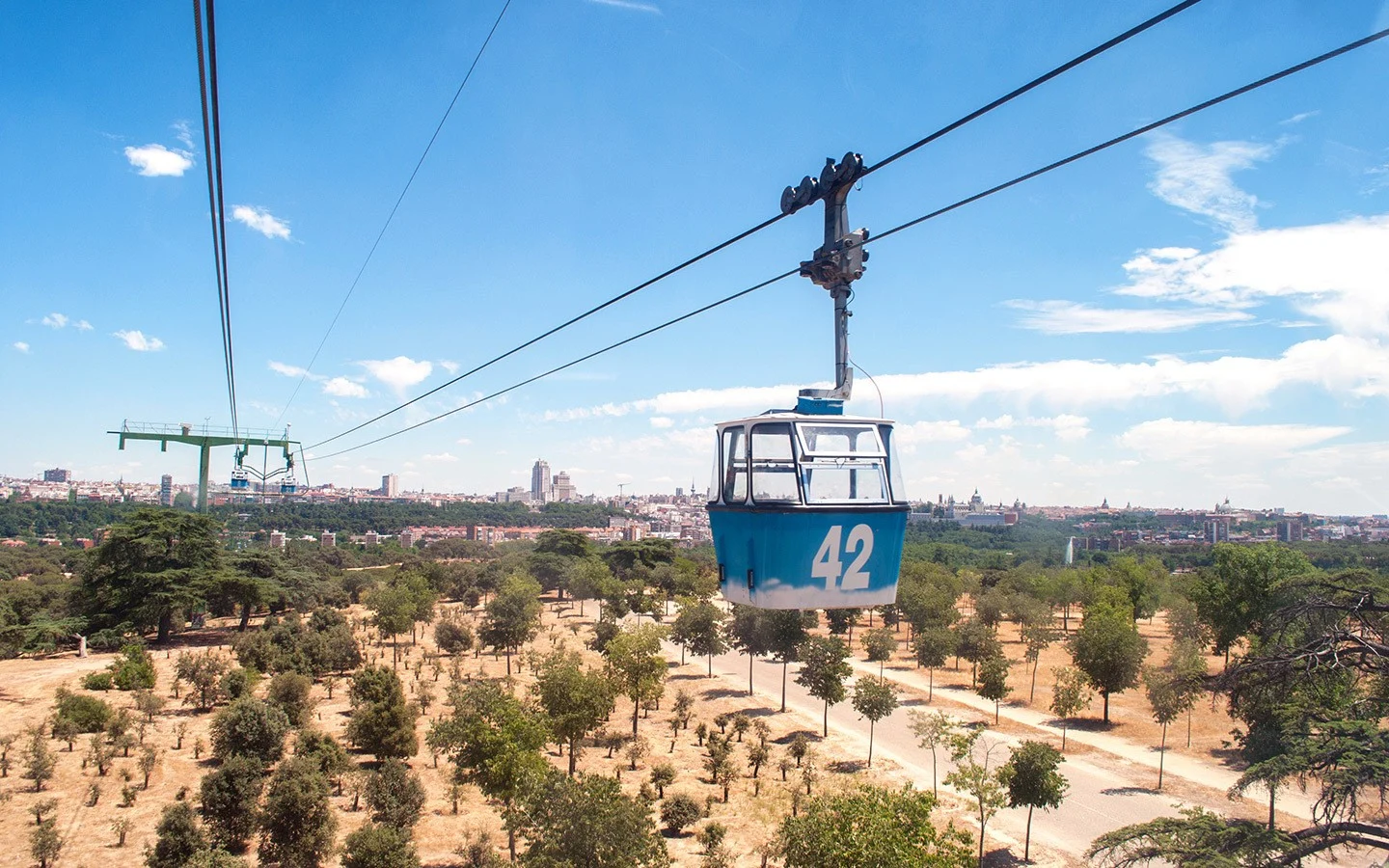
Day 5: Porto
Spend the next day exploring the laid-back riverside city of Porto. Get lost in the Ribeira, Porto’s medieval old town, with its maze of narrow streets running up into the hillside alongside the River Duoro. Cool off in the shady Jardins do Palácio de Cristal gardens and grab a drink by the riverside in colourful Praça da Ribeira square.
Climb to the top of the 76-metre-high Clérigos Tower and look out across the city’s rooftops. Visit the ornate Lello Bookshop – whose lavish staircase was the inspiration for the Hogwarts library in the Harry Potter books – and admire the traditional blue and white painted azulejo tiles which cover the walls of São Bento train station.

There are six bridges across the River Duoro which which link Porto with neighbouring Vila Nova de Gaia – including the arching Dom Luís I bridge. Take a boat tour* on board a traditional rabelo port barge, which takes 45 minutes to sail below all six of the bridges, with some great views of Porto’s riverside along the way.
Vila Nova de Gaia is the home of port-making, and you can visit the cellars of well-known brands like Taylor’s, Graham’s and Croft for a tour and tasting to find out more about how its made. And make sure to try some petiscos – the lesser-known Portuguese version of tapas, perfect with a refreshing glass of white port and tonic on a warm evening.
Read more: Exploring the Ribeira: Getting lost in Porto old town
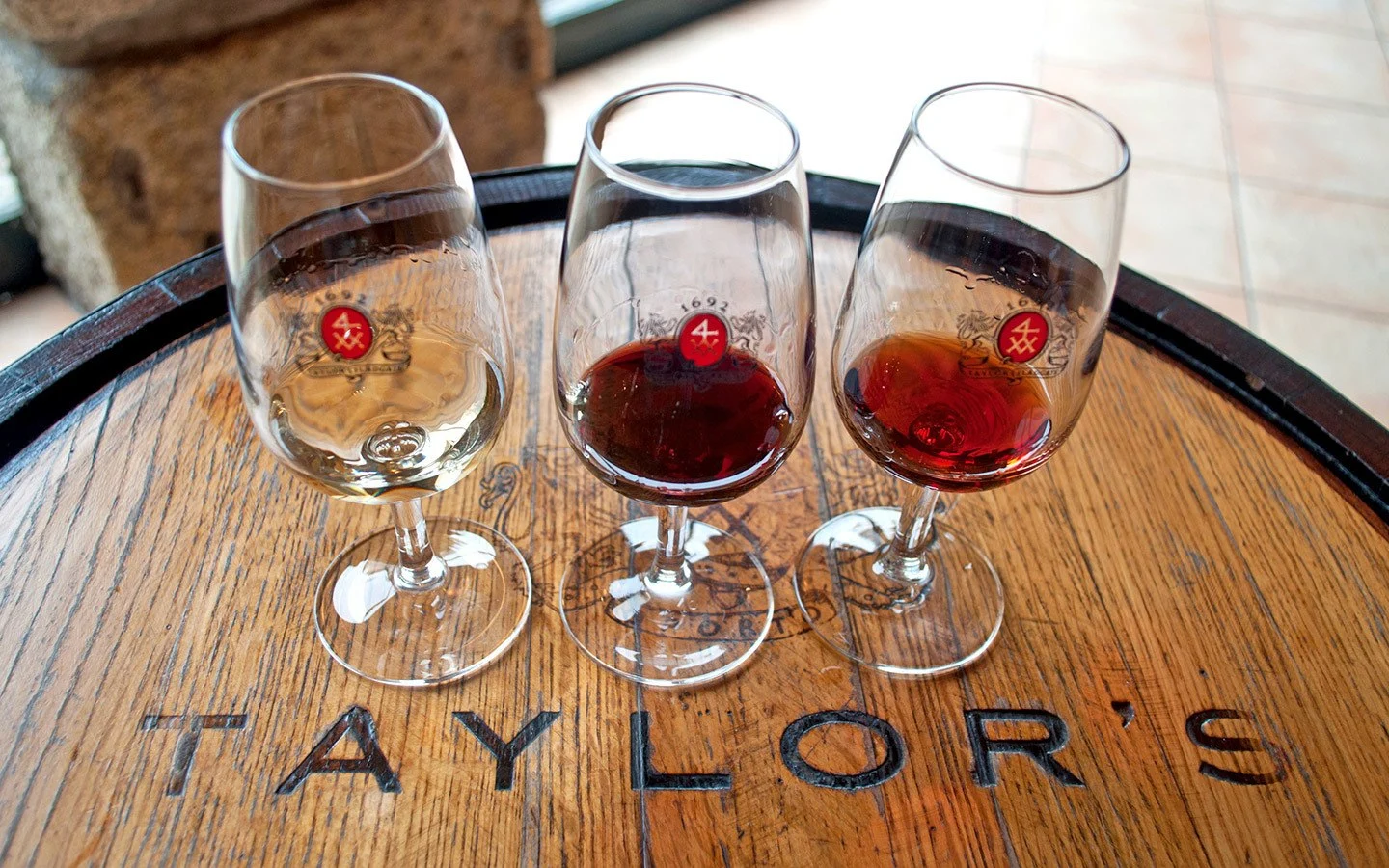
Day 6: Porto > Lisbon
Finish your trip across Spain and Portugal by train by travelling south down the Portuguese coast to Lisbon in just under 3 hours. Catch an Alfa Pendular high-speed tilting train from Porto’s Campanha station at 09.32 and you’ll arrive into Lisbon Santa Apolónia at 12.30. Then you have the rest of the day to spend in the Portuguese capital.
Wander through the grand Praça do Comércio square and explore the narrow winding cobblestone streets of medieval Alfama, the city’s oldest district, where you’ll find Lisbon’s Cathedral and the hilltop São Jorge Castle. Prepare yourself for a workout as Lisbon is one hilly city – though that does make for some fantastic views.
Climb to the top of the Miradouro São Pedro de Alcantara or the Miradouro do Graça (or you can catch the funicular or tram) to look out across Lisbon’s red roofs. You can also take a budget city sightseeing tour on board Lisbon’s bright yellow retro No 28 trams.

Take a boat trip down the Tagus River to Belém, where you’ll find the Jerónimos Monastery and Belém Tower. And make sure to try Portuguese specialities like bacalhau (salt cod), ginjinha (cherry liqueur) and of course the infamous – and delicious – pastéis de nata custard tarts. You can try dishes from top local chefs at the Time Out Market food hall.
Where to stay in Lisbon: The boutique Brown’s Central Hotel* in the Baixa Pombalina downtown district features stylish vintage-meets-modern touches like Roberts radios and retro lamps. It’s close to metro and tram stops and has a brasserie and Art Deco-style cocktail bar which plays host to exhibitions and performances.

Day 7: Lisbon
Spend the last day of your Spain and Portugal rail trip seeing more of Lisbon. Or if the sun’s shining you could visit one of the sandy beaches just outside the city – take a local train to Praia de Carcavelos from Cais do Sodré on the end of the green Metro line.
Then if you’re flying back home, Lisbon’s airport is 20 minutes by Metro from the city centre. Or you can pre-book a transfer to the airport with Welcome Pickups*.

More time?
If you’ve got more time you could add on day trips from Lisbon to the colourful palaces of Sintra or the medieval city of Évora. Or if you feel like relaxing on the beach, you could travel south to Lagos on the Algarve coast (4.5 hours) for golden sands and clear seas. And if you want to go further, a ferry connects the Algarve with the island of Madeira during the summer – taking 24 hours to travel between Portimao and Funchal.
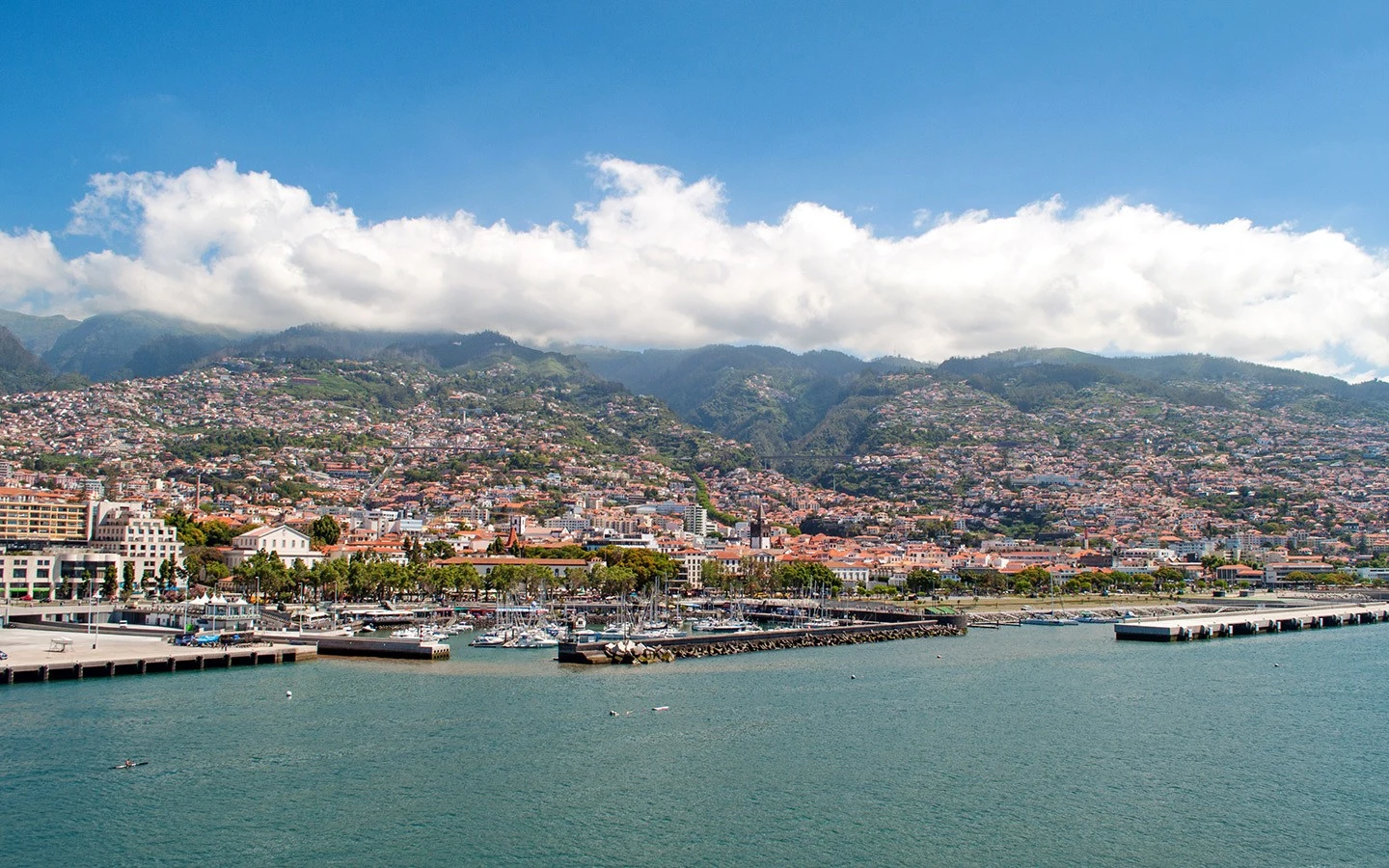
How much does it cost?
When you’re planning a European rail trip, you can either book individual tickets or get a railpass, which can be a better deal if you’re under 28, want more flexibility or are booking late. Here’s how the prices break down for the two different options on this route.
Individual tickets
Ticket prices vary depending on how early you book, with a limited number of cheap tickets available. So book as early as possible (on most routes you can book 3–4 months in advance) but beware these tickets are non-transferable so you’re tied to a specific train. Using the cheapest fares, the cost of trains on this route starts at €76.65 per person.
- Barcelona > Valencia: from €12.35
- Valencia > Madrid: from €7
- Madrid > Porto: from €47.80
- Porto > Lisbon: from €9.50

The railpass option
There are also various rail passes available through InterRail (for European residents) and Eurail (for non-European residents), which cover individual countries or the whole region and are valid for different periods of time, varying from four days to three months.
The Spain and Portugal by train itinerary involves four travel days across two countries, so the best option is the Global Pass for 4 travel days within 1 month. This costs €246 for adults, €185 for youths (aged 12–27) or €221 for seniors (aged 60+) in second class.

As well as the pass, you also need to pay an extra compulsory reservation fee for all trains in Spain and for high-speed services in Portugal. For this trip, the reservation fees come to €28, broken down as below, meaning the overall railpass cost starts from €274.
- Barcelona > Valencia: €6.50
- Valencia > Madrid: €10
- Madrid > Porto: €6.50
- Porto > Lisbon: €5
Reservations can be made at any train station in the country or for Spanish trains they can be made online through the InterRail/Eurail reservations service for a fee of €2.

How to book
There are a variety of websites where you can book European train journeys, but often the best deals are though the official railway company sites for each country. For this trip these are Renfe (Spain) and Portuguese Railways (Portugal).
You can also book tickets for train travel in Italy with Omio* or The Trainline. The advantage is these sites are in English, you can see prices in €, £ or $, use international credit cards and print or use mobile tickets, but they do both charge a small booking fee.
Trains within Portugal can only be booked through Portuguese Railways, so you’d need to book tickets for Vigo to Porto and Porto to Lisbon separately.
Don’t want to do it yourself? You can also book this One-week Spain and Portugal by train itinerary* as a package through our partners Byway, the flight-free holiday platform, which includes transport and accommodation.
Save for later

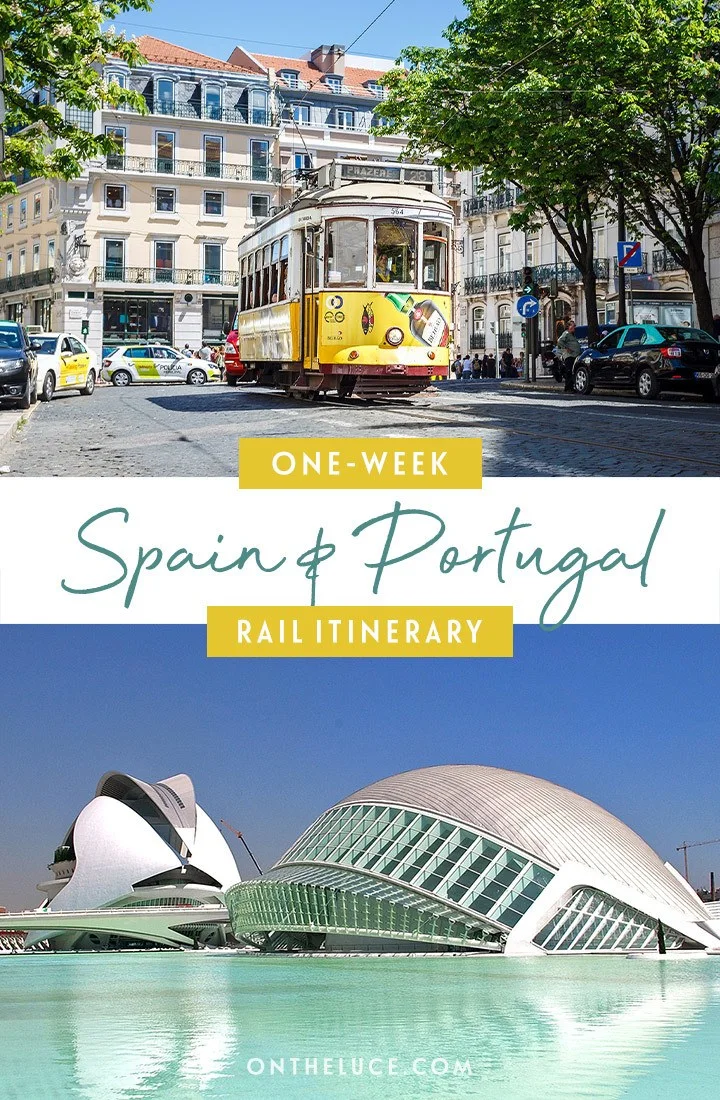

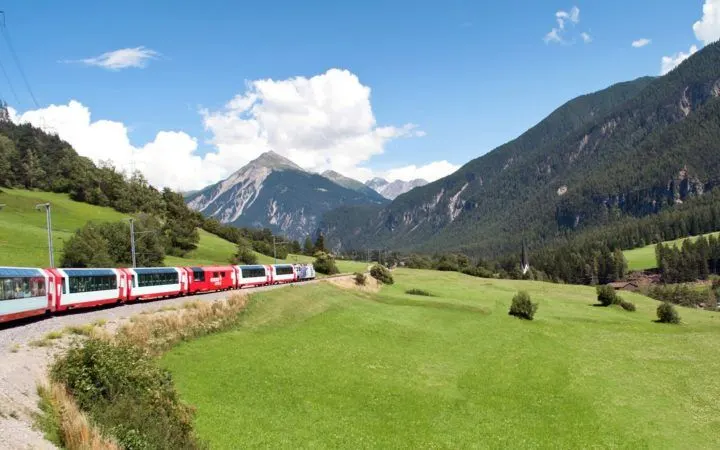

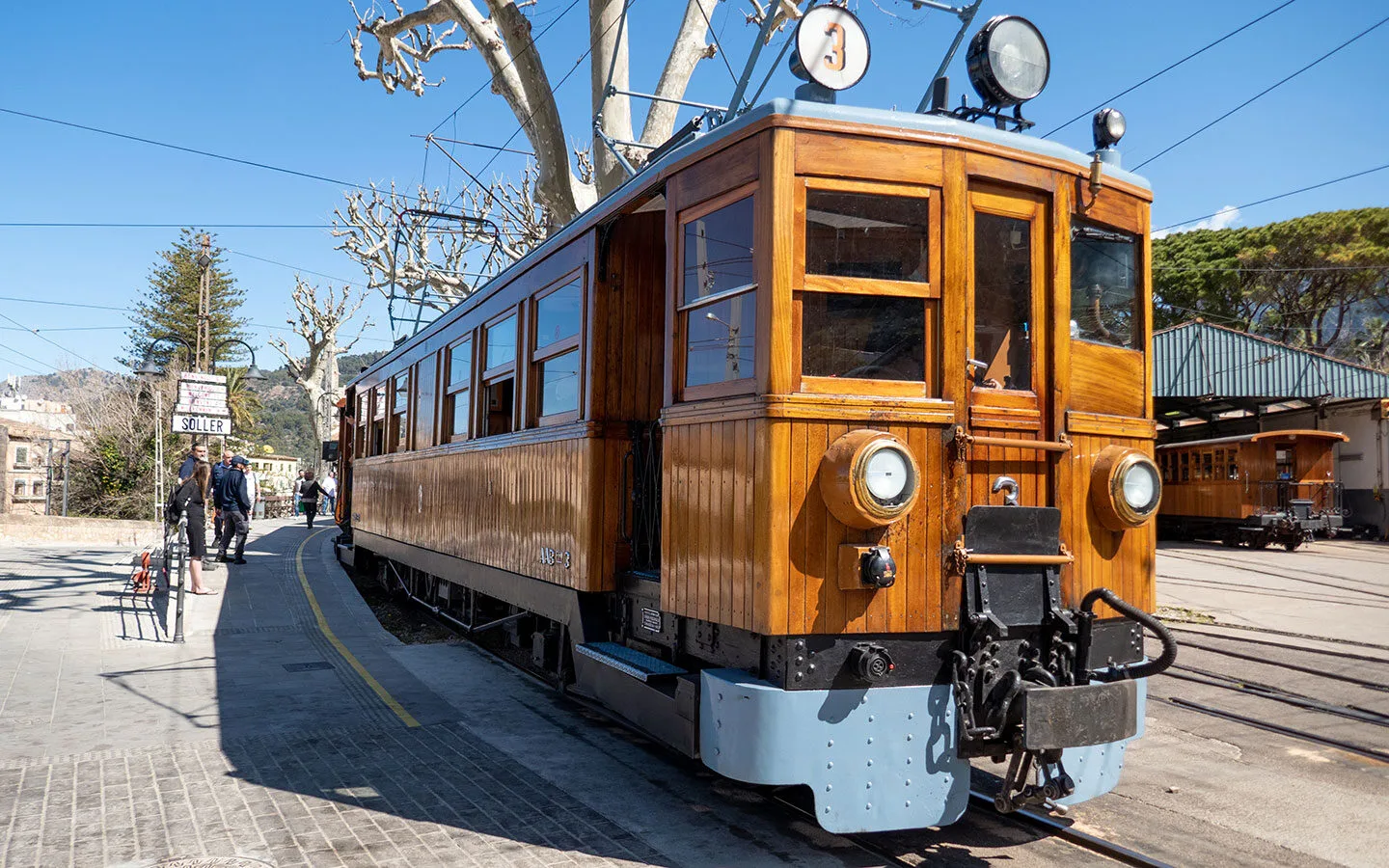
Shelly
Saturday 27th of August 2022
This may be a naive question…,what do you do with your bags while you wait to check into the hotel?
Lucy Dodsworth
Sunday 28th of August 2022
Hi Shelly, if you're staying at a hotel they will usually let you leave your bags there before check on – otherwise there are often left luggage lockers at stations of website like Stasher.com list places where you can store baggage for a small fee.
Danny
Tuesday 23rd of August 2022
Thanks for such a well written article, Lucy.
I’m hoping to fly in to Lisbon in late Dec 2022 through the first week of Jan 2023 and do the trip in reverse from Lisbon to Barcelona, and then coming back to Lisbon for my return trip to the US.
The only question is should I fly to Lisbon from Barcelona or take the train for the return trip too.
Lucy Dodsworth
Sunday 28th of August 2022
Thank you! To do the journey from Lisbon by train would mean an overnight stay in Madrid but if you have the time then no reason not to add on the extra train trip rather than fly.
Jess
Monday 4th of April 2022
Hi Lucy,
When did you take this trip? I'm looking up trains and it says that there is no train service between Madrid and Porto. Only buses. This was the case on the train line and ACP rail websites.
Lucy Dodsworth
Friday 8th of April 2022
Hi Jess, all the train details were checked and updated in March and I've just checked again today on the RENFE site. You may need to book in two sections Mardid > Vigo and Vigo > Porto and you generally can't buy tickets for Portuguese trains via third party sites like Trainline so better to try the RENFE site.
Shelby
Friday 3rd of July 2020
Can you do this trip in reverse where you start in Porto stop in all the same places end in Barcelona and then take a train to Paris then down thru Italy?
Lucy Dodsworth
Friday 3rd of July 2020
Yes the timings would need tweaking slightly but yes that should work fine – it's 6.5 hours from Barcelona to Paris by high-speed train and there is also a sleeper service, and from there you can travel by day or night train to Milan and on through Italy.
Stuart Forster
Wednesday 3rd of June 2020
I saw that Portugal has reopened to UK travellers. I find it a great place to spend time and love the idea of travelling across the Iberian peninsula.
Lucy Dodsworth
Wednesday 3rd of June 2020
Portugal is such an underrated country – so much to see, and some fantastic food and drink too.